Constantinople, 1129
The scroll made its way to the Patriarch's hands. It was snatched, read, and hastily discarded as its most recent reader rose from his desk and strode out of his office. "The Basileus has called an Emergency Session and has plans to discuss the future of the Patriarch later in the deliberations."
Patriarch Nicholas III, whether of Alexandria or Constantinople, strode from his office with rare purpose and determination. He was approached by several Patriarchal Guards, but waved them off as he continued walking, easily making his way through the labyrinthine corridors of the Offices. The common criticism of the Patriarch was that he never got out and met people. This was about to change, but a pit stop was required first.
Motioning three hooded Patriarchal Guards over to him, they all climbed in the waiting carriage and it set off.
The initial destination was towards the Patriarchal Vaults, a moderate distance away from the Offices. It was safely located away from the church district, so another part of the city would feel the full majesty of Orthodoxy, but not on the other side of town so the journey was not overly arduous.
Unlike the Offices, which towered over the majority of structures in Constantinople, the Vaults were fairly unassuming. The architecture was ornate, yes, but the size of the building was modest. It was, in the simplest of terms, a glorified warehouse, a storage room where anything from trinkets to confiscated material to even corpses of enemies were located.
The carriage arrived. The Patriarch, nodding to the two additional Guards stationed at the front entrance, took a lit torch and proceeded inside, alone. As the door shut behind him, leaving the leader of Orthodoxy in near-total darkness, the five guards could only look at each other and contemplate. Unauthorized access to the Vaults and its contents were strictly forbidden, of course, but over the years the guards snuck peeks at what was inside, marvelling at the displays they could see and dreaming about the ones they could not. Only the utmost of discipline prevented them from actually venturing inside the Vaults and exploring its full assortment of treasures.
Inside, the Patriarch waved his torch and walked, not pausing at all to admire or examine what his guards outside only dreamed about. At least a dozen identical copies of the beautiful armor he had given to Makedonios Ksanthopoulos sat unadmired, as did piles of silver and gold. Rare texts were left undisturbed, as was the centerpiece of the Vaults: a giant, gold statue of the Crucifixion, sculpted in the Classical style.
No, the Crucifixion was just a distraction. The true treasure was tucked away in a the Vaults: a smaller, ivory sculpture of Christ in a holy pose. The Patriarch finally paused from his march, pacing in front of this statue again and again, mumbling to himself. After a while, he stepped directly in front of the sculpture and genuflected.
Instantly, the ground sunk. A perfect circle a few feet in diameter, the Patriarch contained in it, slowly started moving down to a secret, underground level.
For all the lore told about what lay in the Offices or the known part of the Vaults, there were no stories about this level. Inside contained the true treasures of Orthodoxy and Christianity, unbeholden to any man except for the current Patriarch of Constantinople. The knowledge of this place was transferred via letter; the current Patriarch, before his health would inevitably take a turn for the worse, wrote of the Lower Level and put it with his will. Upon his death, the new Patriarch would read the letter, learn the secret, and then promptly burn it.
Because the Lower Level was probably the greatest-kept secret in the world, there was nobody to maintain its upkeep. The air was dank and stale and also unplentiful. The Patriarch coughed twice upon breathing it. His torch was fast eating the oxygen as well. This was another security system designed to maintain the secrecy of the Lower Level: You had to know what you were getting and you had to be quick about it. If you did not follow these two rules, then you were dead.
Keeping this in mind, the Patriarch quickly moved through the unmentionable holiest of relics and records of prophecy, leaving them, as usual, hidden to the world. Of course, his desired item was near the back, for its value was great even among the objects hidden in the Lower Level.
He spotted a gold glint and snatched it, already moving back to the entrance while carefully inserting the object into his robes. There was no time to examine it, not down here. He would do so in the relative light of the main Vaults, make sure he removed the correct artifact, and then make his way back to the carriage. He hoped that nobody would notice the dirt on his shoes.
After riding the genuflection platform back up to the statue of Christ, the Patriarch walked back to the giant golden Crucifixion statue. That plus the torch light was ample enough to illuminate his artifact, which seemed to glow on its own.
It was a beautiful dagger, perfectly balanced, with the point sharpened to perfection. It would cut skin at the slightest brush and had a very good chance of doing the same to harder objects. The Patriarch had little doubt that the point would stay sharp for an unnaturally long time. The hilt was pure gold and had religious marks expertly carved in it: the Crucifixion, of course, but Old Testament scenes as well, the kind where God's Will was fulfilled at the cost of thousands of heathen lives.
Then there was the jewel set into it, the jewel that shined even brighter than the golden hilt. A ruby, otherwise flawless aside from a dark smudge set into its very center. This smudge was actually blood, dried blood, dried blood scraped off the True Cross some time after the Crucifixion. There were no tools that could possibly have inserted it into the ruby without leaving a mark, leaving only one explanation as far as the Patriarch was concerned.
He wasn't certain if anybody knew of the dagger's existence, or even if anybody had heard its legend, but if there were any that did, surely the very blood of Christ residing inside the ruby would leave them all in awe.
The time had come to act, and Patriarch Nicholas III had a perfect instrument in which to assist him. While containing the substance of the hero of the New Testament, the dagger would assist in Old Testament work: righting what was wrong by force.
Once again slipping the dagger into his robes, the Patriarch exited the Vaults and, with his three hooded guards, climbed into the carriage. This time it departed in the direction of the Magnaura.











 Reply With Quote
Reply With Quote
Bookmarks